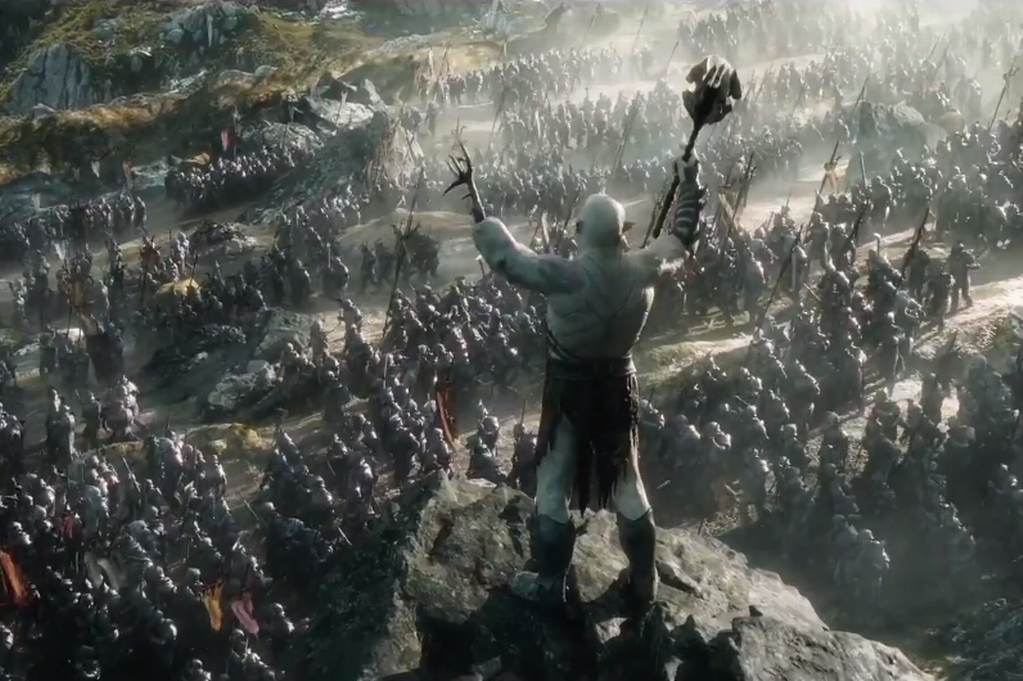'The Hobbit: The Battle of the Five Armies' Review
Neither here nor there
Film review by Isaac Handelman
The Hobbit: The Battle of the Five Armies tries simultaneously to be the culmination of The Hobbit trilogy, the missing link to the Lord of the Rings trilogy, and the “defining chapter” of Peter Jackson’s epic “Middle-earth saga." The result is a film that struggles to live up to its lofty ambitions.
That’s more than can be said for perpetually ignored protagonist Bilbo Baggins, who has few ambitions at all during this final chapter. This time around, the titular hobbit does very little over the course of the film’s two-and-a-half-hour duration. Martin Freeman again does quite well with the material he’s given, showcasing his stellar deadpan comic delivery and ensuring that Bilbo is, far and away, the most relatable of The Hobbit’s huge ensemble of characters. But as far as the events of the main narrative go, Bilbo is much more an observer than an active participant.
The film’s scope is more confined than has ever before been seen in the series, a fact that feels at odds with The Hobbit’s intense desire to be seen as a sweeping epic on the scale of The Lord of the Rings. Armies is mostly concerned with depicting the battle for the mountain of Erebor which, following the fight against the vicious dragon Smaug, is a hotly contested area. Several parties have become intrigued by the location, not only for the untold riches within its depths, but, in the case of the orc army led by Azog, for its strategic location. Character focuses include Thorin Oakenshield (Richard Armitage), who boasts the strongest character arc in the film, and Gandalf (Ian McKellen) whose role in the on-screen proceedings is relatively tangential this time around.
The orcs are as faceless malicious as ever, and are rendered in same sleek, weightless CGI that has harmed their imposingness throughout the entire Hobbit series. And in this entry, they’re less effective in battle than ever before. Though we’re clued in early on that these are specialty orcs have been trained for war since childhood, they fall like cannon fodder, crumbling before the tremendous might of untrained townspeople wielding rudimentary blades and Bilbo’s throwing of small stones.
The Hobbit’s unwavering reliance on CGI extends to most of the film’s action sequences. Many living characters are depicted using computer generation. This makes for a few undeniably impressive set-piece moments, like when a platoon of elven warriors volleys over a wall of entrenched dwarves to join the fight against the orcs, but it’s also responsible for Armies’ high volume of preposterous deus ex machina.
These out-of-nowhere avoidances of death are numerous during Armies’ high-octane culminating battle, which encompasses more than half of the film’s duration. They range from unlikely but forgivable events -- such as when Bard (Luke Evans) rides a wooden cart downhill to perfectly plant his blade in an orc’s chest -- to laughable, outright dismissals of the rules of physics -- such as when Legolas (Orlando Bloom) hops up a hilariously slow stream of falling stones to safety. Though such logical shortcomings are a dime a dozen in today's blockbuster realm, they're especially noticeable and obnoxious in Armies, asking audience members to suspend their disbelief on an all too frequent basis.
 Despite all of the ridiculousness on display during Armies’ extended final conflict, the sequence as a whole manages not to overstay its welcome, remaining nimbly entertaining thanks to its brisk pacing. The sequence is exciting and, if you’re willing to forgive the lack of practical effects on display, visually impressive. Furthermore, Armies is ballsy enough to kill off a few major players whose demises I genuinely did not expect to see. These deaths pay off in emotionally rewarding ways, which helps to ease the pain of the obtuse logic that’s so often on display.
Despite all of the ridiculousness on display during Armies’ extended final conflict, the sequence as a whole manages not to overstay its welcome, remaining nimbly entertaining thanks to its brisk pacing. The sequence is exciting and, if you’re willing to forgive the lack of practical effects on display, visually impressive. Furthermore, Armies is ballsy enough to kill off a few major players whose demises I genuinely did not expect to see. These deaths pay off in emotionally rewarding ways, which helps to ease the pain of the obtuse logic that’s so often on display.
Outside of Armies’ central struggle for Erebor, the film tries to tie cohesively into The Lord of the Rings, acting as a sort of bridging chapter between The Hobbit trilogy and its predecessors (but chronological successors). Basically boiling down to a single, extended sequence that’s almost entirely removed from the main conflict, this attempt comes across as a half-baked shot at giving The Hobbit trilogy larger implications beyond the simple treasure hunt tale that Tolkien originally crafted it to be.
That’s always been one of the main caveats of The Hobbit films: their need to be seen as fantasy epics when their story would be better served as a simple, brief prelude to The Lord of the Rings. Jackson and company do nothing to address this criticism in The Battle of the Five Armies, and instead focus on delivering a slam-bang finale. Without the consistent strength of character interactions that bolstered the previous Hobbit entries, Armies only defines The Hobbit trilogy as a highly inferior return trip to Middle-earth.






Comments
Post a Comment